The Role and Potential of Timber in Construction for Achieving Climate Neutrality Objectives in Latvia
Abstract
1. Introduction
- Public sector role model;
- Support for research and innovation;
- Sustainability and life cycle criteria in procurement procedures;
- Carbon certification system taking into account the offsetting role of wood products;
- Analysis of barriers related to formal, legal, and technical requirements;
- Training and professional development.
- Building height: In the case of cross-laminated timber (CLT), the practical limit is often 8–12 storeys, whereas concrete buildings are not subject to such restrictions.
- Load-bearing requirements: Heavy loads or long spans are more practical in reinforced concrete or steel structures.
- Exposure to moisture: Reinforced concrete is generally preferred for structures in humid environments.
- Fire safety and related insurance constraints: Insurance premiums for timber structures are usually higher.
- There are limitations on constructing large timber buildings, related to material fire safety requirements, transport conditions, and building durability. Therefore, this study specifically focuses on building types where timber construction faces no significant restrictions, such as private houses, ancillary buildings, and small public buildings, as well as appropriately sized engineering structures.
- Although there are no direct restrictions in Latvia on designing any type of building in timber, it is always necessary to seek economic and sustainability advantages, while being aware of the construction sector’s role in achieving CO2 targets. Thanks to the work of the expert group, the Ministry of Economics, together with the Ministry of the Interior (Emergency Service), is already reviewing regulatory acts to remove unjustified restrictions, allowing more than 90% of all buildings designed in the country to be executed in timber.
- In addition to the above, the role of society and building clients in making economic and sustainability decisions must be particularly emphasised. If the private residential construction sector is well-developed, the opposite is true for larger residential (apartment) and public building construction: only the client’s willingness to choose timber as a material, along with appropriate state support (economic, regulatory, and administrative burden reduction), can promote further development of the timber industry and the creation or re-profiling of companies.
2. Materials and Methods
- Analysis of policy planning documents;
- Analysis of timber resource availability;
- Analysis of the timber product market;
- Analysis of timber construction.
- Modelling economic benefits;
- Application of timber construction materials in civil engineering structures;
- Enhancement in educational content and opportunities.
- The research is based on the analysis of specific political documents and regulations referenced in the study.
- The Latvian statistical data on buildings used in the study are based on the building classification according to Cabinet of Ministers Regulation No. 326, “Building Classification Regulations.”
- The study covers the period from 2010 to 2025.
- The study relies on the construction regulatory acts that were in force at the beginning of the research, as during the study (including the work of the expert group), changes were made both to fire safety requirements and to general building construction standards.
- The study reflects the opinions of a narrow circle of experts regarding the use of timber in engineering structures, since this material has not been widely used for a long time, and a broad expert pool cannot be identified. Rather, it involves research experts who aim to promote the development (revival) of this sector.
- The study uses specific and comprehensive results from interviews with the expert group.
- Alignment with national agendas: Documents may be formulated to support priority sector directions (e.g., forestry and timber export competitiveness), which can exaggerate expected benefits or downplay risks.
- Institutional authorship bias: Materials prepared by ministries and industry organisations may reflect the strategic interests of specific institutions (including the risk of “greenwashing”).
- Selection and availability bias: Publicly available, more recent, or Latvian/English-language documents may be overrepresented compared to less accessible sources.
- Temporal and cyclical bias: Policy cycles (e.g., pre-election periods, EU funding planning rounds) may influence rhetoric and the ambition of targets.
- Confirmation bias: Researchers’ initial hypotheses may unconsciously influence interpretation.
- Implementation gap: Goals expressed in documents may not reflect actual implementation (due to regulatory and market barriers, or capacity constraints).
3. Aspects of Timber Building Construction in Latvia
3.1. Climate Neutrality and Sustainable Construction Objectives in Latvian Policy Planning Documents
3.1.1. Latvia 2030 Sustainable Development Strategy and the National Development Plan (NDP)
3.1.2. Latvia’s Climate Neutrality Strategy to 2050
- Reduction in GHG emissions in all economic sectors;
- Enhancement in CO2 sequestration.
3.1.3. National Energy and Climate Plan (NECP) 2021–2030
- Promoting the use of locally produced materials by increasing timber use in construction;
- Establishing new facilities to process currently exported roundwood into value-added timber products, thereby supporting circular economy principles and technologies.
3.1.4. Latvian Construction Sector Strategy
- Climate neutrality and emission reduction (development of low-carbon construction products—identification of construction products and mechanisms with lower or close-to-zero CO2eq. emissions (research and development) and production);
- Promotion of the use of local resources in construction, which includes public sector leadership in sustainability (construction of new buildings owned by the state and municipalities and their capital companies, mainly from wood or other solid biomass raw materials), integration of local resources into building renovation, and reconstruction and construction of new buildings.
3.2. Forest Resources in Latvia
3.3. The Market for Timber Products in Latvia
- Industrial roundwood (excluding fuelwood);
- Fuelwood;
- Charcoal;
- Wood chips, sawdust, and wood waste;
- Wood pellets and wood residues (agglomerated or similar forms);
- Sawn or split timber (thickness > 6 mm).
3.4. The Current Situation in the Timber Building Sector in Latvia
- Log buildings—Walls are formed by horizontally placed and interlocked round logs;
- Timber frame buildings—The structural core consists of a wooden frame;
- Hybrid buildings—Construction intentionally combines various materials (e.g., wood, concrete, steel, glass);
- Wood-panel insulated buildings—Structures with thermal insulation are provided by wood-based panels.
- Single-family houses;
- Multi-family residential buildings;
- Shared housing for various social groups.
- Hotels and similar accommodation facilities;
- Office buildings;
- Wholesale and retail trade buildings;
- Transport and communications buildings;
- Industrial and warehouse buildings;
- Buildings for public entertainment, education, and health care;
- Other non-residential buildings (Other non-residential buildings, which are buildings of penal institutions, prisons, defence forces, border guards, police and firefighting services, water closets, outbuildings of households, individual garages, individual baths, cellars, summer kitchens, greenhouses, security guards, gatehouses, individual garden houses, outhouses not otherwise classified, etc.).
4. Results and Discussion: Evaluation of Timber Building Development Opportunities in Latvia
4.1. PESTEL Analysis of Timber Use in the Construction Sector
- P—Political Factors
- E—Economic Factors
- S—Social Factors
- T—Technological Factors
- E—Environmental Factors
- L—Legal Factors
4.2. SWOT Analysis of Timber Use in the Construction Sector
- Strengths
- Renewable, low-carbon material that stores sequestered CO2;
- Strong national tradition and public acceptance of timber construction;
- Abundant forest resources under diverse ownership;
- Suitable for both new builds and retrofits; high energy performance;
- Prefabrication allows faster, lighter, and more flexible construction with less road impact;
- Strong research, education base, and positive economic spillovers across sectors;
- Can improve housing quality and affordability.
- Weaknesses
- Continued reliance on imported, non-renewable materials;
- Limited expertise in modern timber engineering;
- High export share of raw timber, low domestic processing capacity;
- Energy-intensive drying processes, exposed to volatile energy markets;
- Conservative forest policies constrain harvesting;
- High upfront capital costs and limited enterprise resources;
- Ambiguities in building codes and regulations;
- Underuse of timber in large-scale retrofits.
- Opportunities
- Policy support for domestic timber use and resource mobilisation;
- Expansion of manufacturing into high-value, long-lifespan timber products;
- EU funding for R&D, innovation, and sustainable materials;
- Education system adaptable to specialised training;
- Use in energy-efficient retrofits and renewable energy integration;
- New financial instruments for timber projects;
- Export promotion of prefab and processed timber products;
- Digitalisation and automation in construction.
- Threats/Barriers
- Vulnerability to global timber and energy price fluctuations;
- Complex and inconsistent regulations across jurisdictions;
- Higher legal/technical hurdles vs. conventional construction;
- Financing challenges, especially in rural regions;
- Slow economic growth, population decline, and labour shortages;
- Risks of missing LULUCF targets, sanctions, or delayed EU regulation compliance.
4.3. Policy Recommendations and Solutions
- Loss of habitats: Large-scale logging operations destroy the habitats of numerous plant and animal species that are adapted to specific forest ecosystem types.
- Decline in species populations: Logging reduces populations of species that depend on old-growth trees, deadwood, and the natural structure of forests.
- Environmental changes: Clear-cutting alters the microclimate, moisture regime, and soil conditions, affecting the diversity of plant and fungal communities.
- Sustainable forest management: Practices that provide economic benefits while preserving forest ecosystems and their functions over the long term. These include selective or gradual logging that maintains forest structure and ensures continuous regeneration, as well as reforestation of clear-cut areas, which is mandatory under Latvian legislation, thereby restoring the stand with new, high-quality trees.
- Expansion and management of protected areas: Logging is prohibited or restricted in these areas, preserving habitats for rare and endangered species.
- Innovations and technology: The use of drones and satellite data allows for improved planning of logging operations, identification of sensitive areas, and assessment of forest conditions. Specially designed forest machinery is employed to extract timber with minimal disturbance to the soil surface and forest undergrowth.
5. Conclusions
Author Contributions
Funding
Institutional Review Board Statement
Informed Consent Statement
Data Availability Statement
Conflicts of Interest
Abbreviations
| CLT | Cross-Laminated Timber |
| EESC | European Economic and Social Committee |
| ETS | Emissions Trading System |
| EU | European Union |
| GDP | Gross Domestic Product |
| GHG | Greenhouse Gas |
| GVA | Gross Value Added |
| GWP | Global Warming Potential |
| LCPE | Life Cycle Primary Energy |
| LULUCF | Land Use, Land Use Change, and Forestry |
| NDP | National Development Plan |
| NECP | National Energy and Climate Plan |
| PESTEL | Political, Economic, Social, Technological, Environmental, Legal |
| RC | Reinforced Concrete |
| SWOT | Strengths, Weaknesses, Opportunities, and Threats |
| UNFCCC | United Nations Framework Convention on Climate Change |
References
- United Nations Framework Convention on Climate Change. 1992. Available online: https://unfccc.int/resource/docs/convkp/conveng.pdf (accessed on 12 May 2025).
- Kyoto Protocol to the United Nations Framework Convention on Climate Change. 1998. Available online: https://unfccc.int/resource/docs/convkp/kpeng.pdf (accessed on 12 May 2025).
- Paris Agreement. 2015. Available online: https://unfccc.int/sites/default/files/english_paris_agreement.pdf (accessed on 12 May 2025).
- The European Green Deal. Communication from The Commission. 2019. Available online: https://eur-lex.europa.eu/legal-content/EN/TXT/?uri=CELEX:52019DC0640 (accessed on 15 May 2025).
- Regulation (EU) 2021/1119 of the European Parliament and of the Council Establishing the Framework for Achieving Climate Neutrality. 2021. Available online: https://eur-lex.europa.eu/legal-content/EN/TXT/?uri=celex%3A32021R1119 (accessed on 15 May 2025).
- Communication from the Commission. ‘Fit for 55’: Delivering the EU’s 2030 Climate Target on the Way to Climate Neutrality. 2021. Available online: https://eur-lex.europa.eu/legal-content/EN/TXT/?uri=CELEX:52021DC0550 (accessed on 15 May 2025).
- European Commission. National Energy and Climate Plans, EU Countries’ 10-Year National Energy and Climate Plans for 2021–2030. Available online: https://commission.europa.eu/energy-climate-change-environment/implementation-eu-countries/energy-and-climate-governance-and-reporting/national-energy-and-climate-plans_en (accessed on 15 May 2025).
- Energy System. Buildings. International Energy Agency. 2025. Available online: https://www.iea.org/energy-system/buildings (accessed on 15 May 2025).
- Cardellini, G.; Mijnendonckx, J. Synergies, Energy Efficiency and Circularity in the Renovation Wave. 2022. Available online: https://www.eionet.europa.eu/etcs/etc-cm/products/etc-cm-report-1-2022/@@download/file/ETC%20Report%202022-01.pdf (accessed on 18 May 2025).
- Opinion of the European Economic and Social Committee on ‘Wooden Construction for CO2 Reduction in the Building Sector’. 2022. Available online: https://eur-lex.europa.eu/legal-content/EN/TXT/?uri=CELEX%3A52022AE6006&qid=1750527068912 (accessed on 16 May 2025).
- Hagauer, D.; Lang, B.; Pasteiner, C.; Nemesthoty, K. Empfohlene Umrechnungsfaktoren für Energieholzsortimente bei Holz-bzw. Energiebilanzberechnungen. 2009. Available online: https://www.biomasseverband-ooe.at/uploads/media/Downloads/Publikationen/Umrechnungsfaktoren_Energieholz.pdf (accessed on 18 May 2025).
- Sikkema, R.; Styles, D.; Johnsson, R.; Tobin, B.; Byrne, K. A market inventory of construction wood for residential building in Europe—In the light of the Green Deal and new circular economy ambitions. Sustain. Cities Soc. 2023, 90, 104370. [Google Scholar] [CrossRef]
- Tupenaite, L.; Kaklauskas, A.; Lill, I.; Geipele, I.; Naimaviciene, J.; Kanapeckiene, L.; Kauskale, L. Sustainability Assessment of the New Residential Projects in the Baltic States: A Multiple Criteria Approach. Sustainability 2018, 10, 1387. [Google Scholar] [CrossRef]
- Tupenaite, L.; Zilenaite, V.; Kanapeckiene, L.; Gecys, T.; Geipele, I. Sustainability Assessment of Modern High-Rise Timber Buildings. Sustainability 2021, 13, 8719. [Google Scholar] [CrossRef]
- Tupenaite, L.; Kanapeckiene, L.; Naimaviciene, J. Development of Timber Construction in European Countries: Drivers, Barriers, and Education. In Modern Building Materials, Structures and Techniques; Springer Nature: Cham, Switzerland, 2024; pp. 1–10. [Google Scholar] [CrossRef]
- Hart, J.; Pomponi, F. More Timber in Construction: Unanswered Questions and Future Challenges. Sustainability 2020, 12, 3473. [Google Scholar] [CrossRef]
- Alvitie, I.; Vimpari, J.; Junilla, S. Economic feasibility of wood-based structures—Improving urban carbon neutrality strategies. Environ. Res. Infrastruct. Sustain. 2021, 1, 011002. [Google Scholar] [CrossRef]
- Viļuma, A. The situation with use of wood constructions in contemporary latvian architecture. Moksl.-Liet. Ateitis Sci.-Future Lith. 2017, 9, 9–15. [Google Scholar] [CrossRef]
- Fedotova, K.; Geipele, S. Wood Materials Applied in Civil Engineering and Wood Industry Management in Latvia: Case Study. Adv. Mater. Res. 2013, 804, 141–146. [Google Scholar] [CrossRef]
- Kiesnere, G.; Atstaja, D.; Cudecka-Purina, N.; Susniene, R. The Potential of Wood Construction Waste Circularity. Environments 2024, 11, 231. [Google Scholar] [CrossRef]
- Viļuma, A.; Gabrenas, A. Glulam in Architecture of Latvia and Lithuania. Archit. Urban Plan. 2019, 15, 59–66. [Google Scholar] [CrossRef]
- Vamza, I.; Diaz, F.; Resnais, P.; Radziņa, A.; Blumberga, D. Life Cycle Assessment of Reprocessed Cross Laminated Timber in Latvia. Environ. Clim. Technol. 2021, 25, 58–70. [Google Scholar] [CrossRef]
- Sustainable Development Strategy of Latvia Until 2030 (Latvija 2030). 2010. Available online: https://www.mk.gov.lv/lv/media/15132/download?attachment (accessed on 18 May 2025).
- Latvia’s National Development Plan 2021–2027. 2020. Available online: https://www.mk.gov.lv/lv/media/15165/download?attachment (accessed on 18 May 2025).
- Informative Report Strategy of Latvia for the Achievement of Climate Neutrality by 2050. 2019. Available online: https://unfccc.int/sites/default/files/resource/LTS1_Latvia.pdf (accessed on 18 May 2025).
- Latvia—Final updated National Energy and Climate Plan for 2021–2030. 2024. Available online: https://commission.europa.eu/publications/latvia-final-updated-necp-2021-2030-submitted-2024_en (accessed on 18 May 2025).
- Latvia’s National Inventory Document Under the UNFCCC. 2024. Available online: https://unfccc.int/sites/default/files/resource/LV_NID_31122024.pdf (accessed on 18 May 2025).
- Latvian Construction Industry Strategy for 2025–2030. 2025. Available online: https://www.em.gov.lv/lv/media/20655/download?attachment (accessed on 18 May 2025).
- Regulation (EU) 2020/852 of the European Parliament and of the Council. 2020. Available online: https://eur-lex.europa.eu/eli/reg/2020/852/oj/eng (accessed on 18 May 2025).
- Forest Sector, Statistics. Ministry of Agriculture of Latvia. 2025. Available online: https://www.zm.gov.lv/en/statistics (accessed on 25 May 2025).
- Forests, Forestry and Logging. Eurostat. 2024. Available online: https://ec.europa.eu/eurostat/statistics-explained/index.php?_forestry_and_logging&oldid=655300 (accessed on 8 August 2025).
- Global Forest Resources Assessment 2020: Main Report; Food and Agriculture Organization of the United Nations: Rome, Italy, 2020. [CrossRef]
- Proportion of Forests in 1935 and Early 2018. Central Statistical Bureau. 2019. Available online: https://stat.gov.lv/lv/statistikas-temas/vide/dabas-resursi-geografiskas-zinas/publikacijas-un-infografikas/5222-mezu?themeCode=DRP (accessed on 8 August 2025).
- Statistical Database. Forest Stands and Standing Timber by Main Tree Species 2004–2025. 2025. Available online: https://data.stat.gov.lv/pxweb/en/OSP_PUB/START__NOZ__ME__MEP/MEM040/ (accessed on 25 May 2025).
- Regulations on Felling Trees in the Forest (Noteikumi par koku ciršanu mežā). 2015. Available online: https://likumi.lv/ta/id/253760-noteikumi-par-koku-cirsanu-meza (accessed on 25 May 2025).
- Donis, J. Determining the Growth and Increase of Forest Stands Using the Measured Forest Statistical Inventory Data. 2015. Available online: https://www.silava.lv/petnieciba/petijumi/mezaudzu-augsanas-gaitas-un-pieauguma-noteiksana-izmantojot-parmeritos-meza-statistiskas-inventarizacijas-datus (accessed on 25 May 2025).
- Donis, J. Improving Growth Trajectory Models. 2016. Available online: https://www.silava.lv/petnieciba/petijumi/augsanas-gaitas-modelu-pilnveidosana (accessed on 20 May 2025).
- Kumar, V.; Lo Ricco, M.; Bergman, R.D.; Nepal, P.; Poudyal, N.C. Environmental impact assessment of mass timber, structural steel, and reinforced concrete buildings based on the 2021 international building code provisions. Build. Environ. 2024, 251, 111195. [Google Scholar] [CrossRef]
- Mutlu, E.; Şener, K.; Anil, Ö. Comparison of mass-timber and RC buildings in terms of seismic performance, LCA, and cost in Türkiye. Bull. Earthq. Eng. 2025, 23, 4221–4253. [Google Scholar] [CrossRef]
- Duan, Z.; Qu, H.; Zhang, Q. Life cycle assessment of mass timber construction: A review. Build. Environ. 2022, 221, 109320. [Google Scholar] [CrossRef]
- Ministry of Agriculture of Latvia. Latvian Forest Sector in Facts & Figures. 2023. Available online: https://www.zm.gov.lv/en/media/11529/download?attachment (accessed on 25 May 2025).
- Production and Trade in Primary Products. Sawnwood and Panels. Eurostat. 2022. Available online: https://ec.europa.eu/eurostat/databrowser/view/for_swpan/default/table?lang=en&category=for.for_rpt.for_rptp (accessed on 7 August 2025).
- Statistical Database. Production, Exports and Imports of Wood Products 2017–2023. 2023. Available online: https://stat.gov.lv/en/statistics-themes/business-sectors/forestry/tables/mek010-production-exports-and-imports-wood (accessed on 20 May 2025).
- Rules for the Cadastral Survey of Structures (Būvju kadastrālās uzmērīšanas noteikumi). Cabinet Regulation No. 116. 2023. Available online: https://likumi.lv/ta/id/340512-buvju-kadastralas-uzmerisanas-noteikumi (accessed on 25 May 2025).
- EN 1995-1-1; Eurocode 5: Design of Timber Structures. European Committee for Standardization: Brussels, Belgium, 2004. Available online: https://eurocodes.jrc.ec.europa.eu/EN-Eurocodes/eurocode-5-design-timber-structures (accessed on 25 May 2025).
- Cabinet Regulation No 326 “Structure Classification Regulations”. 2018. Available online: https://likumi.lv/ta/id/299645-buvju-klasifikacijas-noteikumi (accessed on 20 May 2025).
- JSC “Latvijas valsts meži” Office in Dundaga. Available online: http://gadabuve.lv/index.php/as-latvijas-valsts-mezi-birojs-dundaga/ (accessed on 14 August 2025).
- Opening of a Finished Goods Warehouse “Furniers”. Available online: https://www.zemeunvalsts.lv/-latvijas-finiera-rupnicas-furniers-gatavas-produkcijas-noliktavas-atklasana-seminars-koka-buvnieciba-latvija- (accessed on 14 August 2025).
- Central Library in Ogre. Available online: https://www.ogresnovads.lv/lv/filiale/ogres-centrala-biblioteka?utm_source=https%3A%2F%2Fwww.google.com%2F (accessed on 14 August 2025).
- Water Tourism and Sports Center in Jelgava. 2024. Available online: https://www.jelgava.lv/jaunumi/udensturisma-un-sporta-baze-nodota-ekspluatacija/ (accessed on 14 August 2025).
- Commissioned Buildings by Building Type, Region and City. 2024. Available online: https://stat.gov.lv/en/statistics-themes/business-sectors/construction/tables/bue031c-commissioned-buildings-building-type (accessed on 13 August 2025).
- Gross Domestic Product and Value Added—Annual Data. Official statistics of Latvia. 2025. Available online: https://stat.gov.lv/en/statistics-themes/economy/national-accounts (accessed on 25 August 2025).
- Official Statistics of Latvia. Construction and Real Estate. 2025. Available online: https://stat.gov.lv/en/statistics-themes/business-sectors/construction (accessed on 25 August 2025).
- Official Statistics of Latvia. Average Prices of Energy. 2024. Available online: https://stat.gov.lv/en/statistics-themes/business-sectors/energy-3 (accessed on 25 August 2025).
- Bank of Latvia. Financing of the Economy. 2024. Available online: https://datnes.latvijasbanka.lv/fpp/FPP_2024_EN.pdf (accessed on 25 August 2025).
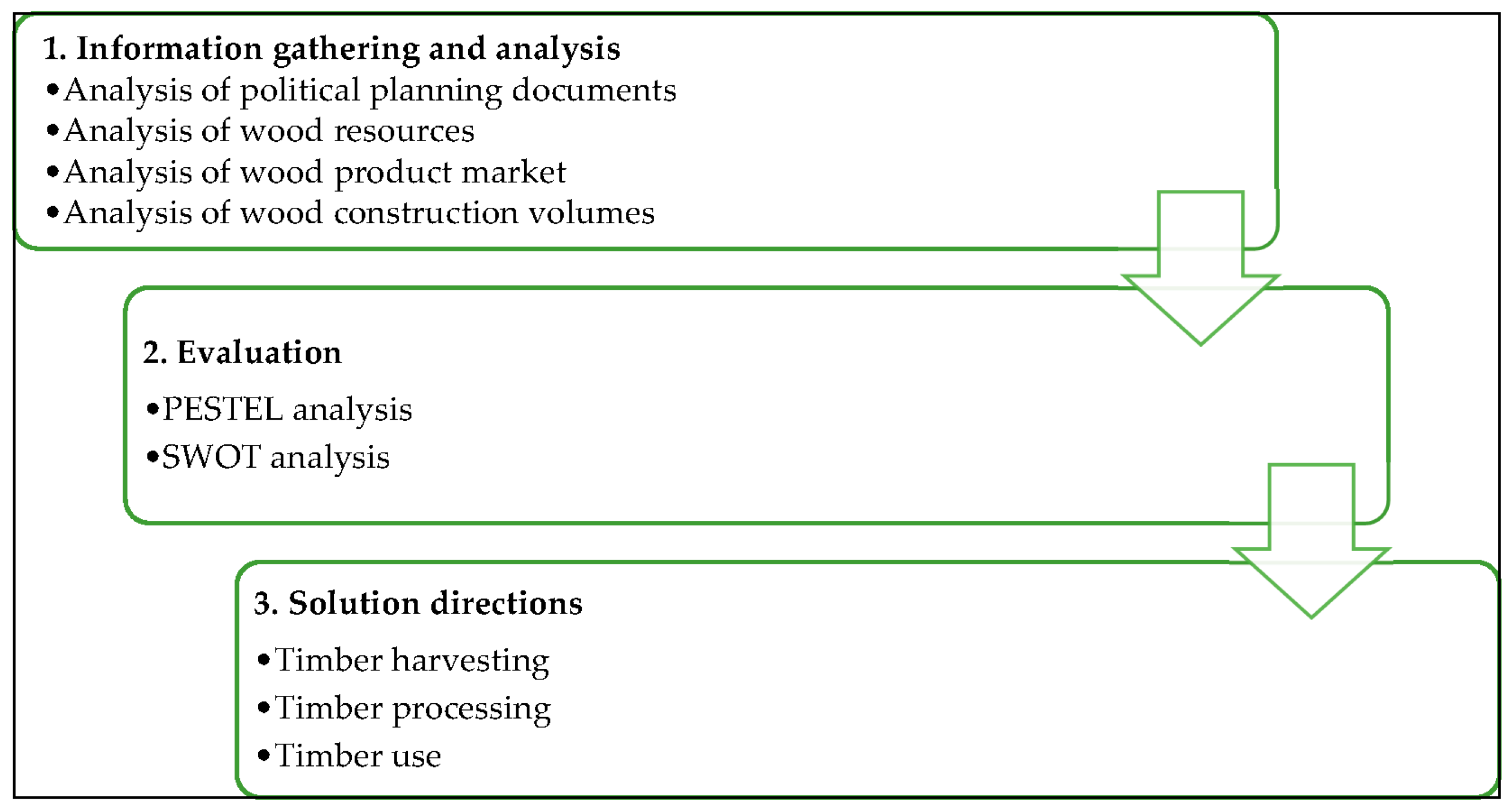
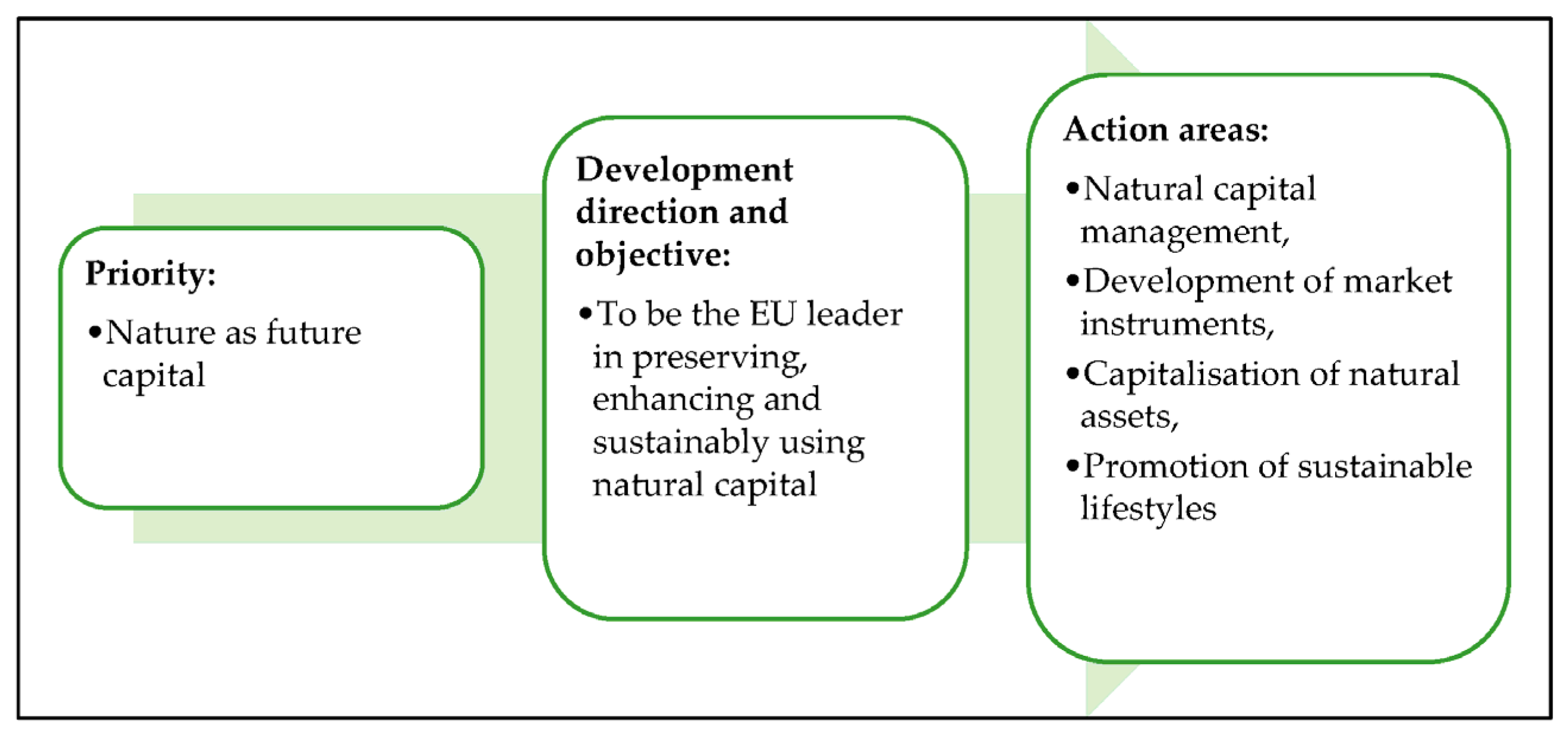
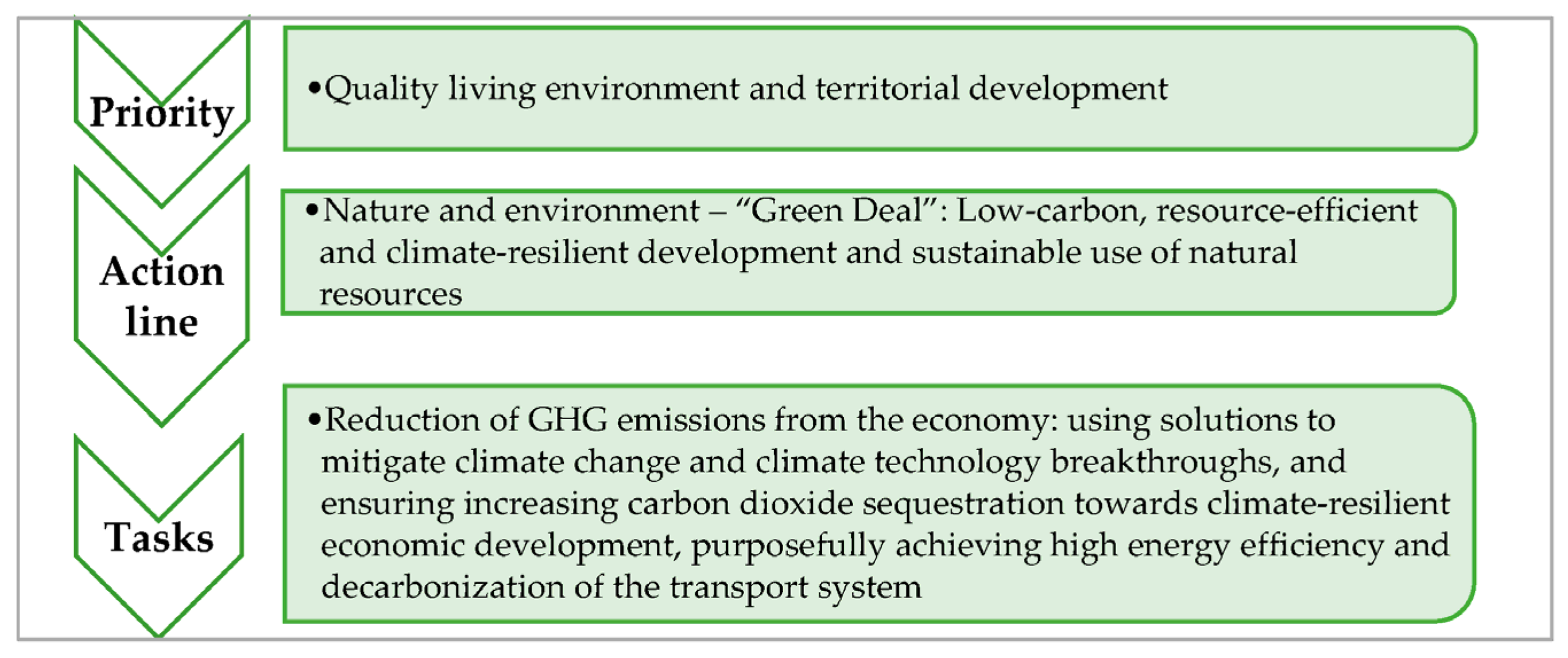
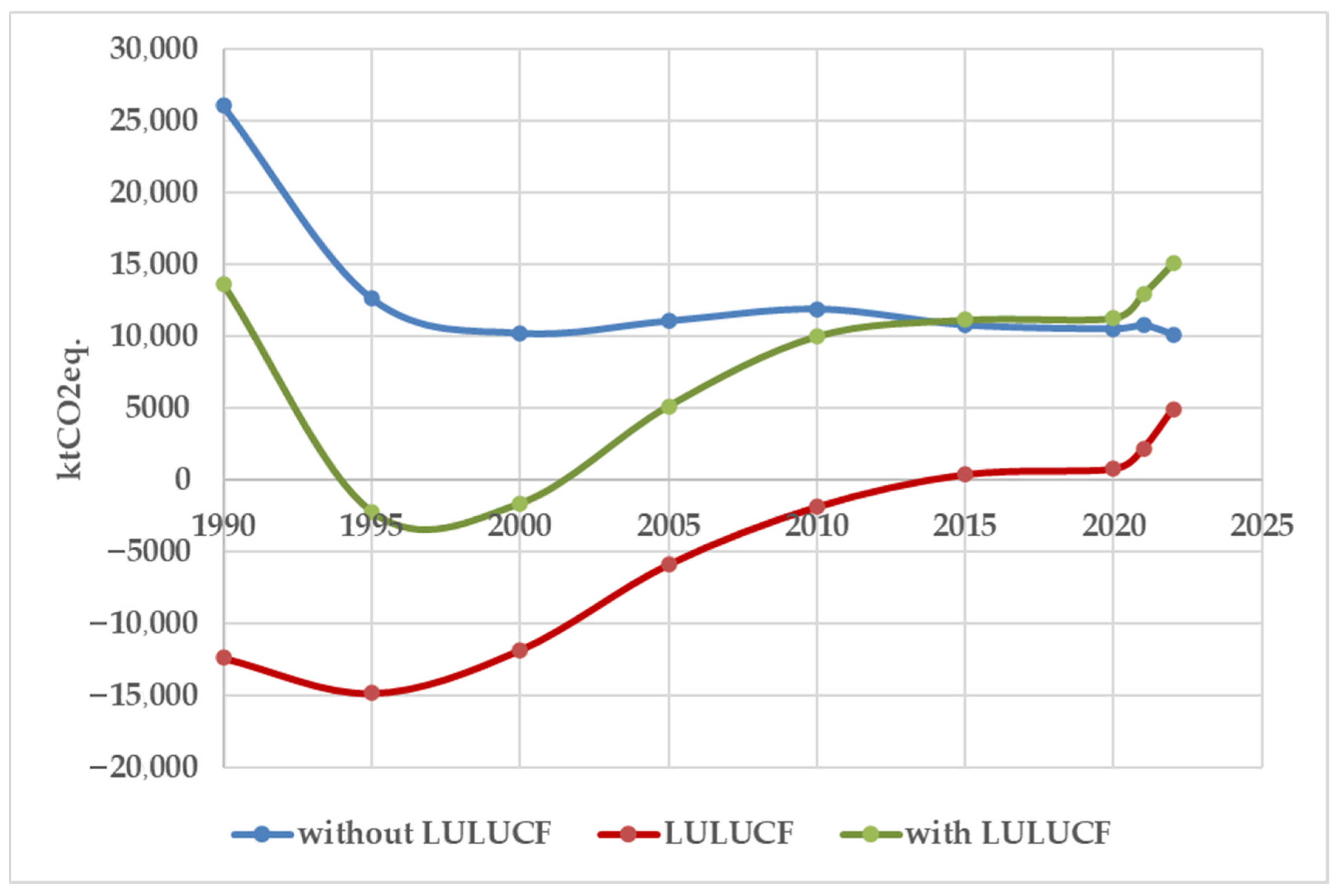
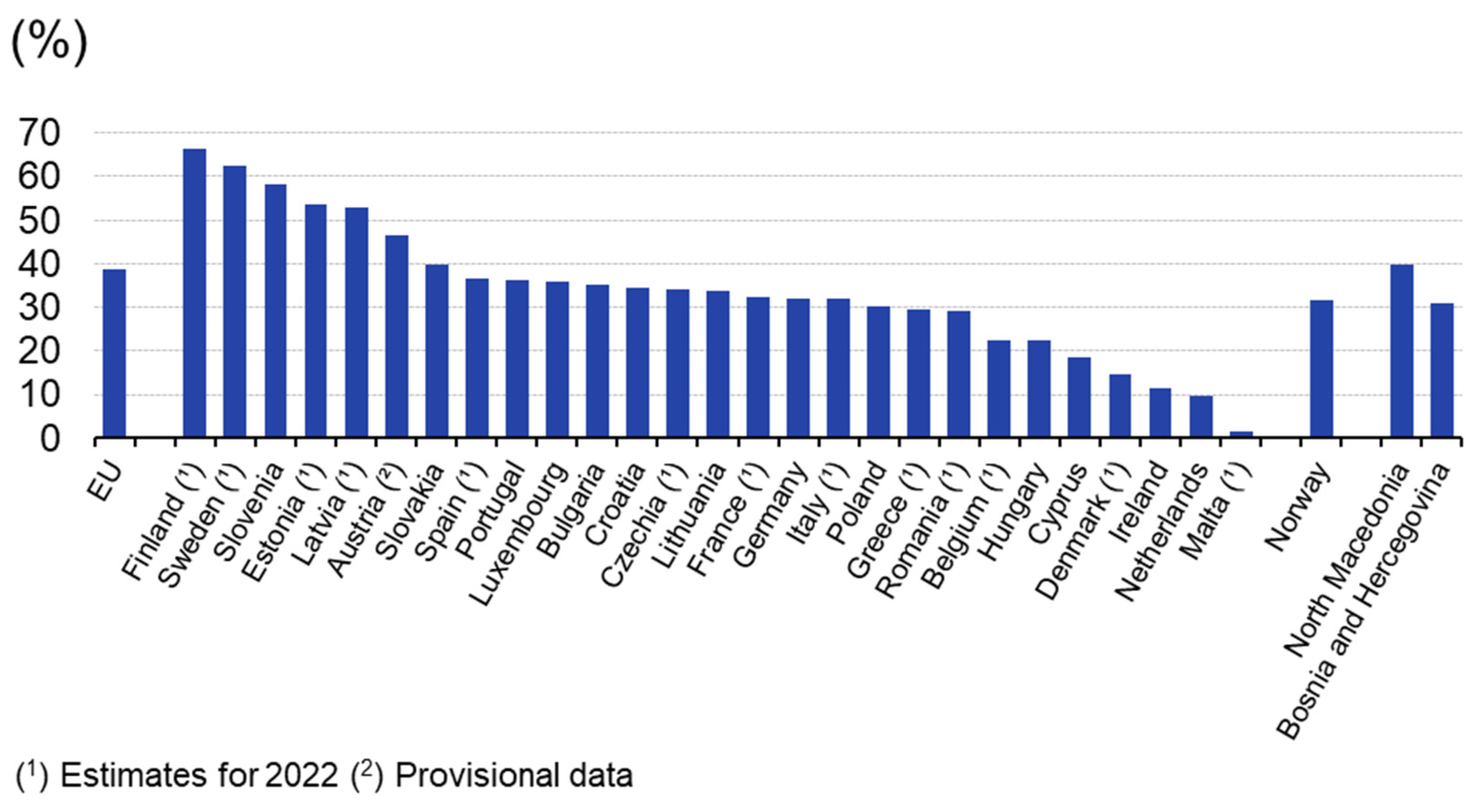
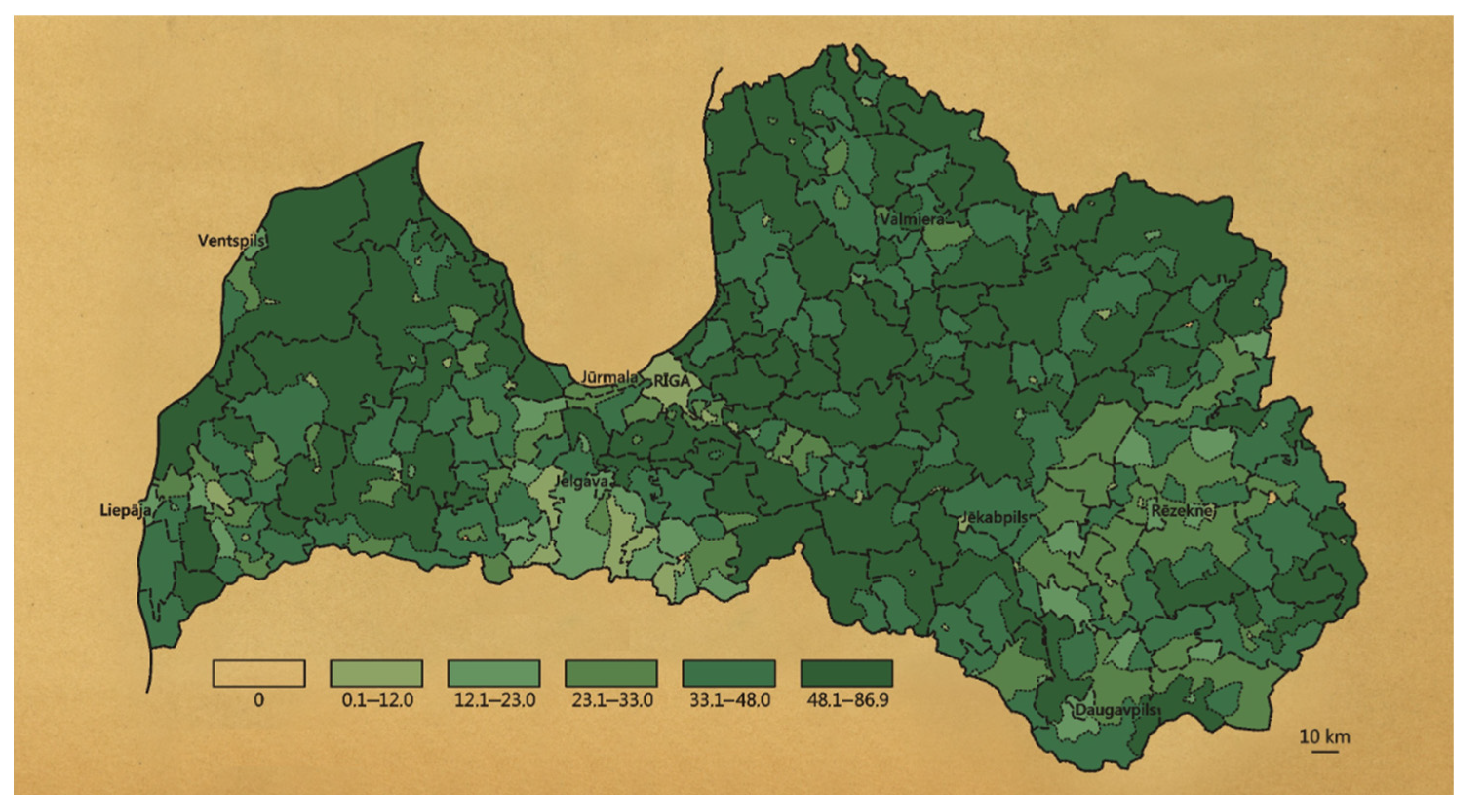

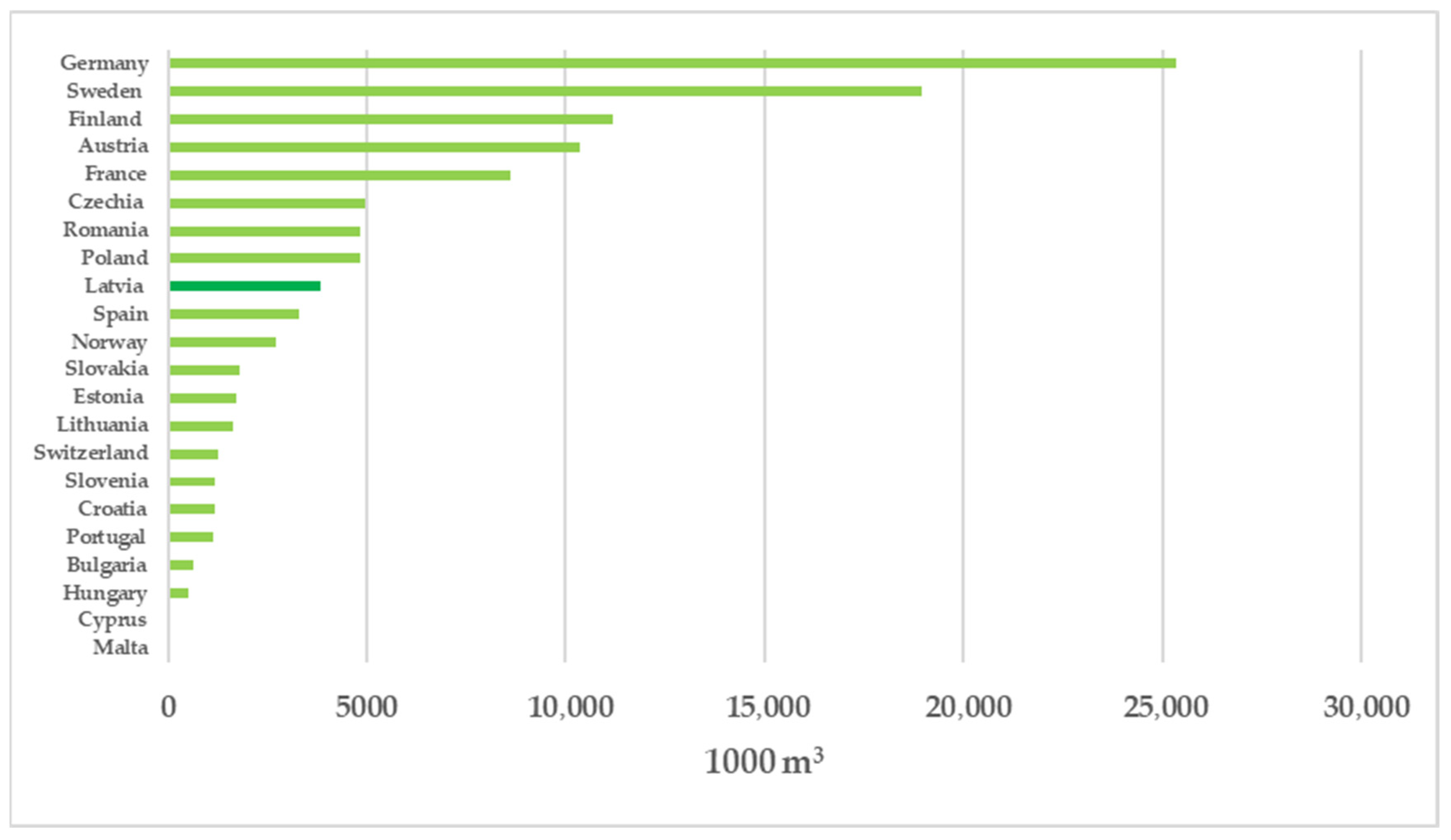
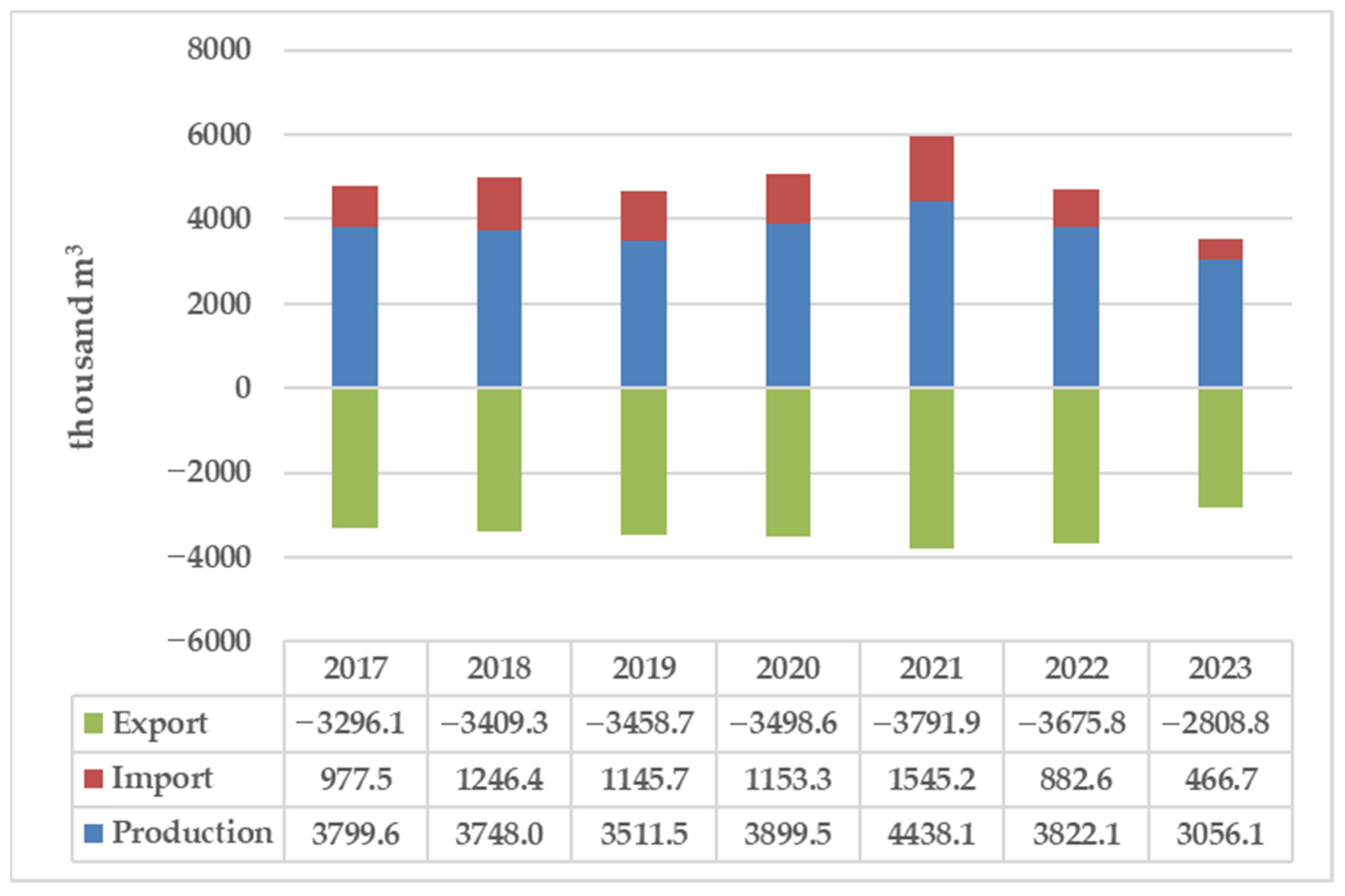
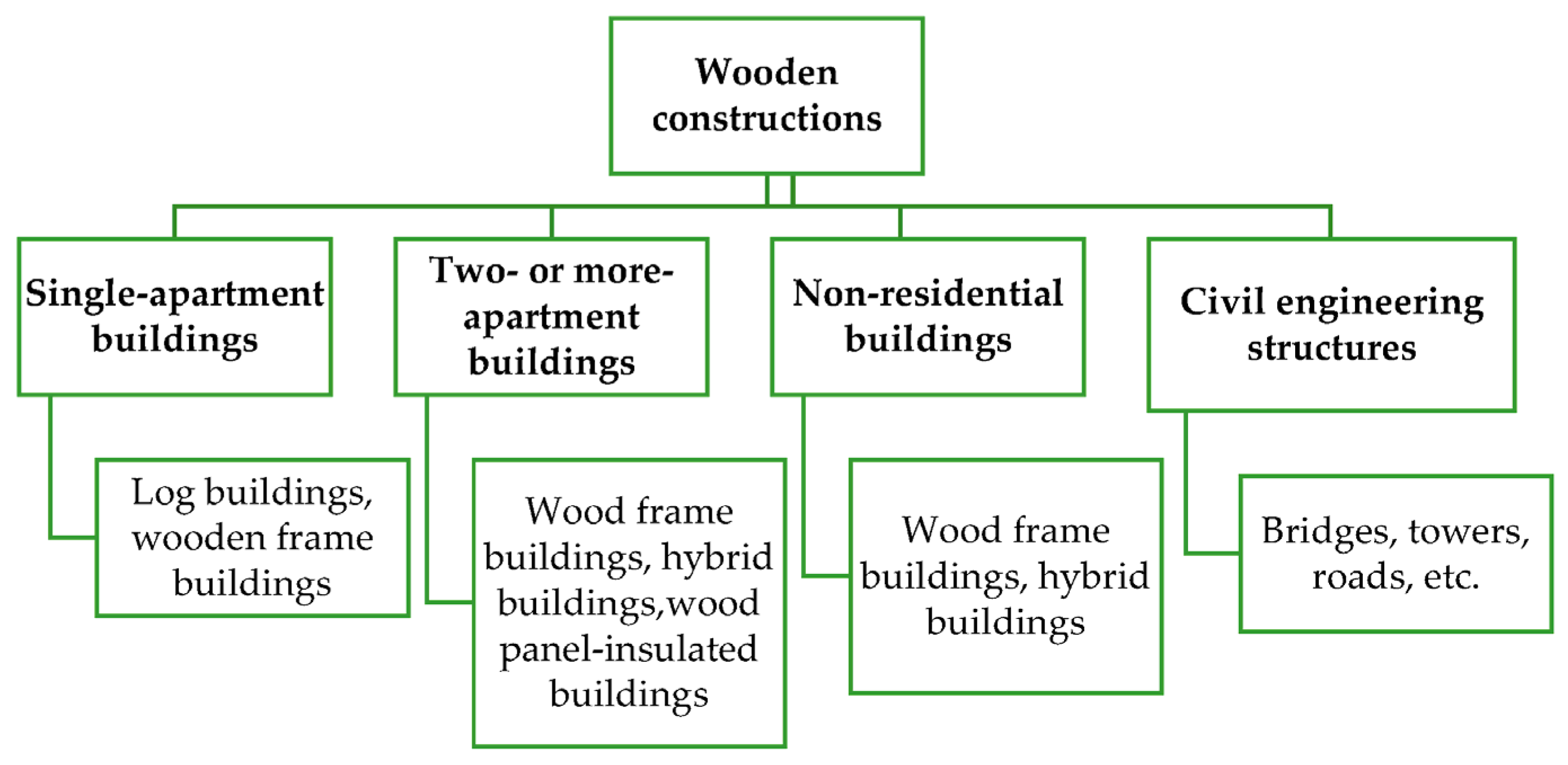

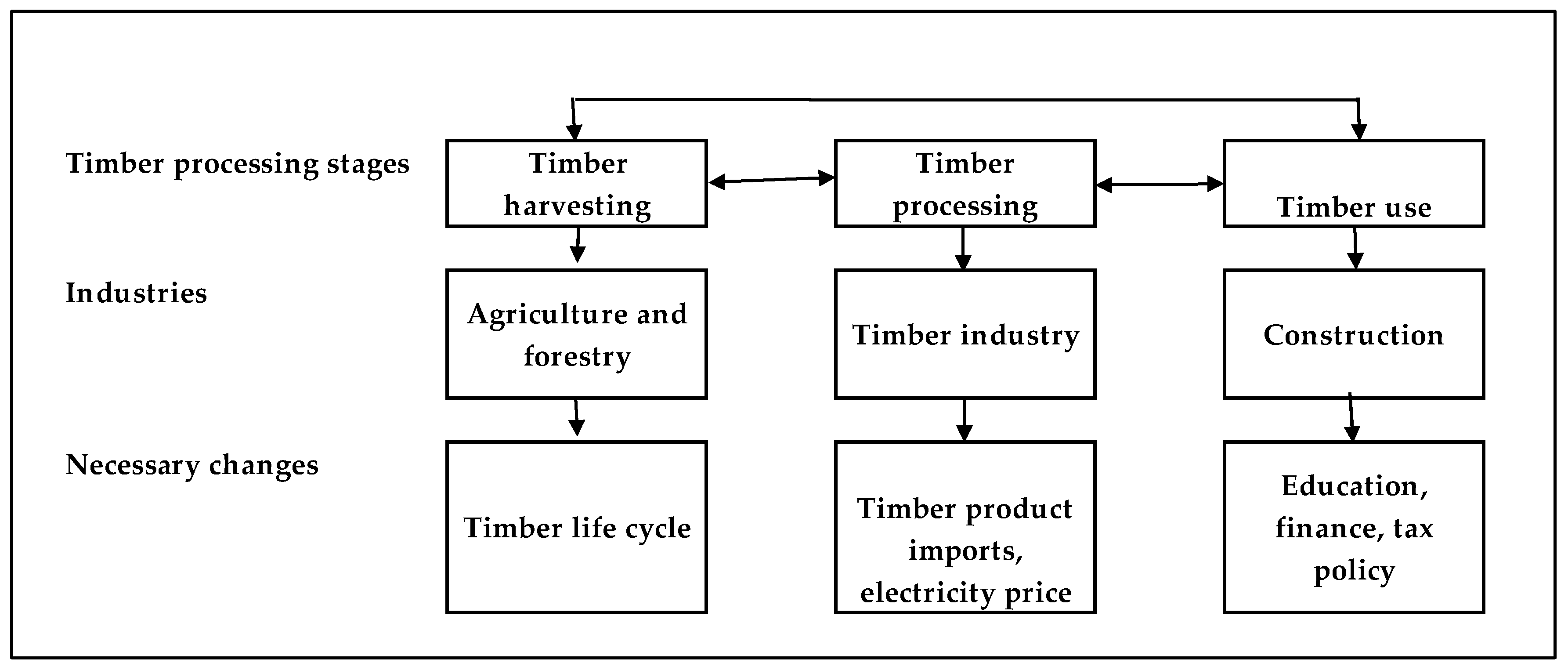
| Document | Strategic Goals | Strategic Directions |
|---|---|---|
| European Green Deal [4] | Achieve EU climate neutrality by 2050 | Supports sustainable, energy-efficient, and resource-efficient economic development; promotes the use of renewable and local resources. |
| Regulation (EU) 2021/1119 European Climate Law [5] | Establishes the framework to achieve climate neutrality in the EU by 2050 | Sets a binding EU target of at least a 55% reduction in GHG emissions by 2030 compared to 1990 levels; provides legal certainty and predictability for planning the transition to a carbon-neutral economy. |
| “Fit for 55” Package [6] | A legislative package to reduce EU GHG emissions by at least 55% by 2030 | Covers energy efficiency, renewable energy, and comprehensive reform of the EU Emissions Trading System (ETS). |
| National Energy and Climate Plans (NECPs) [7] | 10-year plans describing how each Member State intends to meet the EU’s energy and climate targets by 2030 | Outlines approaches to decarbonisation, energy efficiency, energy security, market integration, research, innovation, and competitiveness. |
| 1990 | 2030 | 2040 | 2050 | |
|---|---|---|---|---|
| GHG emissions (excl. LULUCF) | 26,299 | −65% | −85% | Climate neutrality 1 |
| CO2 sequestration and GHG emissions in LULUCF | −9828 | <1047 | 0 2 | |
| Total GHG emissions (incl. LULUCF) | 16,471 | −38% | −76% |
| 2025 | Number | Area, Million m2 | ||||
|---|---|---|---|---|---|---|
| Total Buildings | Wooden Buildings | Proportion of Wooden Buildings | Total Buildings | Wooden Buildings | Proportion of Wooden Buildings | |
| Residential buildings | ||||||
| Single-apartment houses | 319,772 | 179,441 | 56.1% | 39.4 | 17.7 | 44.9% |
| Two- or more-apartment houses | 53,843 | 20,182 | 37.5% | 55.2 | 4.7 | 8.5% |
| Multi-apartment houses of various social groups | 789 | 165 | 20.9% | 1.0 | 0.1 | 6.4% |
| Total residential buildings | 374,404 | 199,788 | 53.4% | 95.5 | 22.4 | 23.5% |
| Non-residential buildings | ||||||
| Hotels | 6582 | 3838 | 58.3% | 2.9 | 0.5 | 17.3% |
| Office buildings | 6977 | 933 | 13.4% | 6.6 | 0.3 | 4.4% |
| Commercial buildings | 8086 | 1942 | 24.0% | 5.5 | 0.3 | 5.6% |
| Communication buildings and garages | 14,560 | 532 | 3.7% | 5.0 | 0.1 | 1.5% |
| Industrial production and warehouses | 49,754 | 2413 | 4.8% | 28.2 | 0.7 | 2.3% |
| Entertainment, education, and health care buildings | 8046 | 1304 | 16.2% | 12.2 | 0.5 | 4.0% |
| Other buildings | 910,903 | 504,418 | 55.4% | 57.8 | 21.6 | 37.4% |
| Total non-residential buildings | 1,004,908 | 515,380 | 51.3% | 118.2 | 23.9 | 20.2% |
| Total | 1,379,312 | 715,168 | 51.7% | 213.7 | 46.3 | 21.7% |
| 2010 | 2015 | 2020 | 2025 | Increase | Increase | |
|---|---|---|---|---|---|---|
| Residential Buildings | Million m2 | % | ||||
| Single-apartment houses | 15.41 | 15.77 | 16.42 | 17.70 | 2.29 | 13.0% |
| Two- or more-apartment houses | 3.89 | 4.21 | 4.39 | 4.68 | 0.79 | 16.9% |
| Multi-apartment houses of various social groups | 0.04 | 0.03 | 0.04 | 0.06 | 0.02 | 32.4% |
| Total residential buildings | 19.34 | 20.01 | 20.85 | 22.44 | 3.10 | 13.8% |
| Non-residential buildings | ||||||
| Hotels | 0.21 | 0.28 | 0.37 | 0.49 | 0.29 | 58.0% |
| Office buildings | 0.20 | 0.21 | 0.25 | 0.29 | 0.09 | 31.6% |
| Commercial buildings | 0.23 | 0.26 | 0.28 | 0.31 | 0.08 | 27.1% |
| Communication buildings and garages | 0.06 | 0.07 | 0.07 | 0.08 | 0.01 | 19.5% |
| Industrial production and warehouses | 0.56 | 0.57 | 0.60 | 0.65 | 0.09 | 14.4% |
| Entertainment, education, and health care buildings | 0.28 | 0.33 | 0.39 | 0.48 | 0.21 | 42.6% |
| Other buildings | 20.58 | 20.83 | 21.23 | 21.60 | 1.02 | 4.7% |
| Total non-residential buildings | 22.11 | 22.55 | 23.19 | 23.91 | 1.80 | 7.5% |
| Total | 41.45 | 42.56 | 44.04 | 46.35 | 4.90 | 21.3% |
| All New Buildings | New Buildings Made of Wood | New Buildings Made of Other Materials | Proportion of New Buildings Made of Wood | |
|---|---|---|---|---|
| Residential Buildings | ||||
| Single-apartment houses | 4630.6 | 2294.1 | 2336.5 | 50% |
| Two- or more-apartment houses | 2225.7 | 789.7 | 1436.0 | 35% |
| Multi-apartment houses of various social groups | 51.9 | 20.3 | 31.6 | 39% |
| Total residential buildings | 6908.2 | 3104.1 | 3804.1 | 45% |
| Non-residential buildings | ||||
| Hotels | 330.9 | 286.8 | 44.1 | 87% |
| Office buildings | 453.4 | 91.0 | 362.4 | 20% |
| Commercial buildings | 787.9 | 84.0 | 703.9 | 11% |
| Communication buildings and garages | 262.8 | 14.9 | 247.9 | 6% |
| Industrial production and warehouses | 3544.1 | 94.3 | 3449.8 | 3% |
| Entertainment, education, and health care buildings | 724.5 | 206.3 | 518.2 | 28% |
| Other buildings | 2684.9 | 1022.3 | 1662.6 | 38% |
| Total non-residential buildings | 8788.5 | 1799.6 | 6988.9 | 20% |
| Total | 15,696.7 | 4903.8 | 10,792.9 | 31% |
| Proposed Activity of Change | Stage of Timber Processing | ||
|---|---|---|---|
| Timber Harvesting | Timber Processing | Timber Use | |
| Shorten harvesting cycles to enable earlier and sustainable use of forest resources | × | ||
| Stabilise energy costs and support renewable energy use in wood processing | × | ||
| Promote public awareness of timber as a construction material | × | ||
| Mandate timber use in state and municipal procurement | × | ||
| Review and adapt regulations (e.g., fire safety) and provide training in timber construction | × | ||
| Incentivise timber use in insulation and renovation through higher support levels | × | ||
| Improve financing access for consumers and producers | × | × | × |
| Adjust tax policies to favour sustainable construction materials | × | ||
| Expand timber-focused education and training across all levels | × | ||
| Explore timber applications in civil engineering (bridges, infrastructure, modular builds) | × | ||
| Support interdisciplinary research | × | × | × |
Disclaimer/Publisher’s Note: The statements, opinions and data contained in all publications are solely those of the individual author(s) and contributor(s) and not of MDPI and/or the editor(s). MDPI and/or the editor(s) disclaim responsibility for any injury to people or property resulting from any ideas, methods, instructions or products referred to in the content. |
© 2025 by the authors. Licensee MDPI, Basel, Switzerland. This article is an open access article distributed under the terms and conditions of the Creative Commons Attribution (CC BY) license (https://creativecommons.org/licenses/by/4.0/).
Share and Cite
Pudzis, E.; Kundziņa, A.; Druķis, P. The Role and Potential of Timber in Construction for Achieving Climate Neutrality Objectives in Latvia. Sustainability 2025, 17, 8247. https://doi.org/10.3390/su17188247
Pudzis E, Kundziņa A, Druķis P. The Role and Potential of Timber in Construction for Achieving Climate Neutrality Objectives in Latvia. Sustainability. 2025; 17(18):8247. https://doi.org/10.3390/su17188247
Chicago/Turabian StylePudzis, Edgars, Antra Kundziņa, and Pēteris Druķis. 2025. "The Role and Potential of Timber in Construction for Achieving Climate Neutrality Objectives in Latvia" Sustainability 17, no. 18: 8247. https://doi.org/10.3390/su17188247
APA StylePudzis, E., Kundziņa, A., & Druķis, P. (2025). The Role and Potential of Timber in Construction for Achieving Climate Neutrality Objectives in Latvia. Sustainability, 17(18), 8247. https://doi.org/10.3390/su17188247





